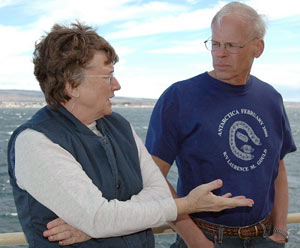Interviews

At the rail of the L.M. Gould as it leaves Punta Arenas, Chile and heads toward Antarctica, biological oceanographer Pat Kremer discusses the cruise plan with Chief Scientist Larry Madin. Kremer will investigate how plankton animals called salps feed, grow, and reproduce in the Southern Ocean near Antarctica. (Photo by K. Madin, WHOI)
Why won’t you be diving on this trip?
The seawater here is about two degrees below freezing, and all the divers have to wear dry suits. They are a lot harder to get into than a wetsuit, they weigh much more, and it requires an extra level of certification to do dry suit diving. I’ll miss diving, but I can get more done in the lab if I’m not out in the dive boat every day—and night.
But some of the total highs, too, are the night dives. Everyone turns off the dive lights for a minute and we play in the bioluminescence (light produced by organisms in the water). You never want to leave; it’s just like magic.
Sometimes on a dive, suddenly everything is perfect, you feel like you belong in the sea. You look around and everything is right: your buoyancy and weight, the clarity of the water, the animals you’re looking at. There is a feeling of weightlessness and infinity; you feel like a jellyfish, at one with the water.
How did you become interested in salps, such odd and obscure animals?
At graduate school at the University of Rhode Island, I studied ctenophores (also called “comb jellies”—predatory transparent jellylike animals.) Not much was known of gelatinous zooplankton in those days. The field was wide open, and that attracted me. It was exciting to ask questions that hadn’t been asked before about how they make their living.
Then I had a chance to meet Larry Madin, and found a whole jelly group at WHOI! I was studying everything that was gelatinous, and Larry was measuring metabolic rates of salps. We collaborated, studying large salp populations in the north Atlantic. We learned an extremely similar species of salp was in the Southern Ocean, and hadn’t been studied much, so we wanted to go and learn about them, even though I had vowed I would never go anywhere cold!
Which was first, your interest in the ocean, or your interest in science?
The ocean came first. I grew up overlooking the Pacific; it was always there; and was part of who I was. In high school I had a chance to participate in an NSF-sponsored summer program on oceanography, marine biology and math. After that summer I knew I wanted to be an oceanographer instead of a marine biologist. I went to Stanford University as an undergraduate, partly because Stanford had a marine station. I spent time there, and it was the first chance I had to do research—then I knew I liked research.
Is there a difference between marine biology and biological oceanography?
If you’re a marine biologist, the biology of creatures in the ocean is your primary interest. If you’re a biological oceanographer, you’re interested in the ecological system that includes the biology, physics, and chemistry of the ocean, a broader view of what’s going on.
What will you be doing on this cruise?
I’m basically in charge of what goes on in the lab, kind of the conductor of the orchestra! Because I’m not diving and collecting, I’ll do the “triage”: the divers go out, collect zooplankton animals individually, put them in jars, and bring them back to the ship. When the collection comes in, I’m in charge of dividing the jars up and giving them to the various projects. I will also do experiments, but it’s vital to keep the whole group organized. Last year, we were here in early December, just the beginning of summer. This year the cruise is toward end of the Antarctic summer, and we expect to see differences, because of the life cycle of salps. We’ll compare food availability and feeding early and late in the season. Best of all, this time we have 15 people—a full complement— all working our project.
Do you like going to sea?
I love it—absolutely love it! That’s one reason I went into oceanography. I would have been very disappointed to not go to sea. One thing that makes me enthusiastic is that I don’t get seasick, so it’s easy for me to work. Some colleagues get really sick at sea, and I always wonder how they stay in oceanography.
What’s the best moments you’ve had at sea?
The very best part is when you get your lab all set up on the ship just the way you want, and there’s your whole world in a small space. There’s no commute time, no distractions, someone else is cooking for you, and you can do nothing but work and there are plenty of animals.
And the worst?
The low point is when you steam to many different places and haven’t been able to find the animals. Then I don’t know what to do with myself. What a privilege you have, to be able to go to sea, to make the trip, and then you can’t be productive because the zooplankton animals aren’t where you expect and you can’t find them—but that’s jelly work for you!
The scariest time I ever had was on a night dive with Larry in the Arabian Sea. (When we dive, we are hooked to each other with ropes called ‘tethers.’) One of the divers, why I don’t know, unhooked from his tether and went drifting off into the blackness alone. Larry went after him, and when we got back after the dive, my heart was pounding because I realized how dangerous that was.
|

